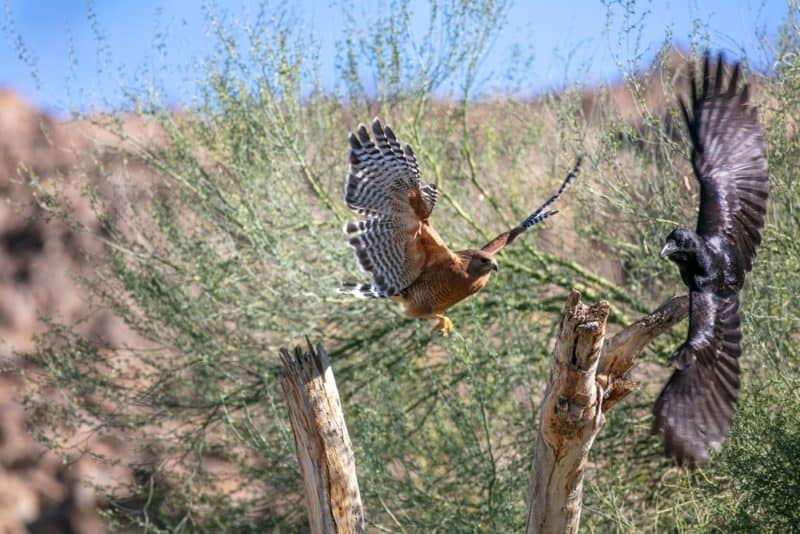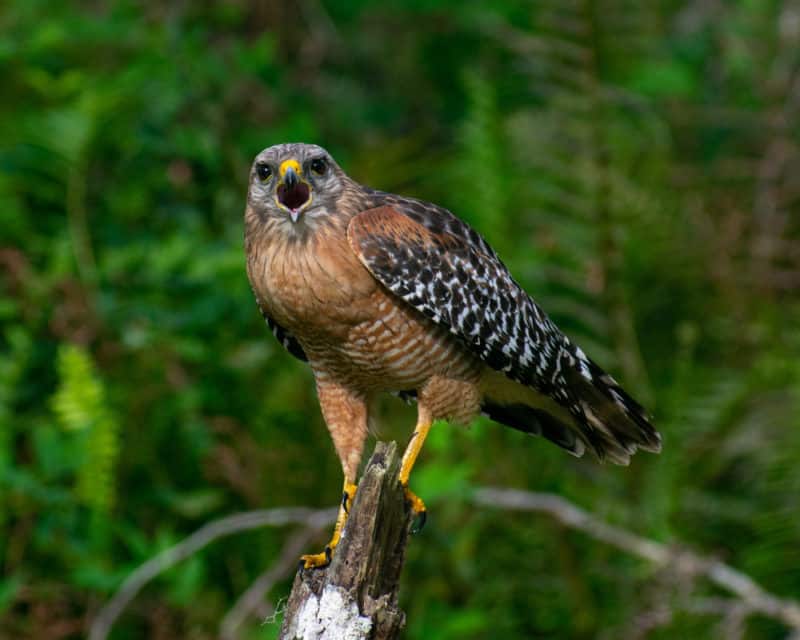Scientific Name- “Buteo lineatus“
The Red-shouldered hawk is a colorful medium-sized hawk from the Buteo genus. It gets its name for the red on its supper shoulders. They primarily inhabit coastal California, western Mexico, the eastern United States, and extreme southeastern Canada.
Red-Shouldered Hawk Description
People sometimes confuse Red-shouldered hawks in flight with Red-tailed hawks. However, red-shouldered hawks are slightly smaller in frame and more lightly made than are red-tails.
When these birds are perched, their red shoulders are easy to pick out as an identifying characteristic.
Another identifying characteristic that Red-shouldered hawks have is when they’re flying is translucent, appearing crescent near the tip of each wing. These are visible from underneath when they’re flying.
Adult birds have brown or greyish heads depending on geographic location and sub-species. Additionally, they have dark curved beaks and proportionately long yellow legs. They are black with white spotting across the back. Their tails, which are relatively long for buteo hawks, are black with thin white bars. The color on their chests and thighs is reddish-brown with white barring.
In size, Red-shouldered hawks are sexually dimorphic with the females being larger than the males.
Adult birds are 15 inches to 19 inches in length. The wingspan of adult birds is 38 inches to 42 inches. Last but not least, they weigh 1.1 to 1.9 pounds.
Red-Shouldered Hawk Range
There are five different sub-species of Red-shouldered hawk that differ in geographic range. They also differ slightly in physical appearance.
- Buteo lineatus elegans-While the eastern sub-species’ ranges overlap somewhat, the western sub-species, “Buteo lineatus elegans” does not overlap. It in coastal Oregon and California as well as western Mexico. Wandering birds from this sub-species are sometimes as far east as Idaho and Utah. These western birds live in the same environment year-round. According to the American Bird Conservancy website, the black and white checkerboard pattern on the backs of these birds is more striking than that on the other 4 sub-species.
- Buteo lineatus lineatus– The eastern and northeastern sub-species is “Buteo lineatus lineatus” You can find these birds in the eastern United States and southern Ontario and New Brunswick in Canada during the summer breeding season. They are mostly permanent residents to their range. However, birds that summer at the extreme northern limits of their range will migrate to southeastern Texas and Mexico for the winter.
- Buteo lineatus texanus– The members of this sub-species are year-round residents of eastern Texas.
- Buteo lineatus alleni– These birds are year-round residents of the southeastern United States, excluding southern Florida.
- Buteo lineatus extimus-These birds are native to southern Florida. According to the American Bird Conservancy website, the members of this particular subspecies are lighter colored than the other four with paler markings.

Behavior
Red-shouldered hawks soar and circle on the air currents with their wings and tail feathers held wide just like all buteo hawks do. However, they also fly low beneath the forest canopy, alternating flapping their wings rapidly and gliding to surprise potential prey animals on the ground. This is more similar to the technique of an accipiter such as a Cooper’s hawk or a Sharp-shinned hawk. Source
More often than not, though, these birds hunt from a perch beneath the forest canopy for unsuspecting prey to pass by.
Red-shouldered hawks are diurnal birds. In the eastern U.S., the Red-shouldered Hawk is the daytime counterpart to the nocturnal Barred Owl. Both birds live in the same range and share the same swampy forest habitat, and prey on the same animals. The Red-shouldered hawk is active during the day, while the Barred owl takes its place after dark.
Red-shouldered Hawks aggressively defend their nesting territory. They will attack intruding hawks, crows, Great horned owls, and even humans if they feel they are a threat to their nesting site.
Interestingly, even though they regard crows as a hated enemy, Red-shouldered hawks occasionally team up with crows to chase an even more hated enemy, the Great horned owl, from their territory.
Red-Shouldered Hawk Prey
Red-shouldered hawks eat small mammals such as squirrels, chipmunks, mice, and voles. They also prey on birds up to the size of a ruffed grouse, amphibians, reptiles, and large insects. Additionally, they will catch small fish and crayfish in shallow water. They are more likely to prey on crayfish in the southeastern United States.
Red-Shouldered Hawk Predators
Nonnesting, Red-shouldered hawks are large, powerful birds with few natural threats. However, nesting or brooding females are more vulnerable to predatory attacks. According to Hawkmountain.org, Great-horned Owls and raccoons are the biggest predatory threat to Red-shouldered hawks as they prey on eggs, young, and adult birds. Martins, fisher cats, and other raptors such as Red-tailed hawks and peregrine falcons are also on the list of potential, Red-shouldered hawk predators.
Red-Shouldered Hawk Mating Behavior
Red-shouldered hawks are monogamous, and they mate for life. Pairs often use the same nesting sites for many consecutive years.
Red-shouldered hawk mating season is from April to July. However, the peak activity time is from April through mid-June. Generally, they are two years of age before they seek out a mate, although they can breed when they are a year old. Courtship for these birds usually lasts around 18 days.
The red-shouldered hawk is quite vocal. This is especially so during courtship mating season. At this time, they’re one of the noisiest birds in the forest. Their typical call is a loud kee-aw. Blue Jays are particularly good at imitating this call and may use it to frighten other birds from the area they’re in.
During courtship, mated Red-shouldered hawk pairs circle and soar together with their wings and tails fanned, and the male will perform sky dances. Sky dances consist of repeatedly making a steep, deep dive and then making a spiraling ascension back to the altitude that he started from.
One other curious that Red-shouldered hawks might do during their courtship fights is turn inverted and fly upside down for short distances.
Nesting Behavior
Red-shouldered hawks will occasionally use conifers, but they generally choose a deciduous tree for a nesting site. Their nest will be below the forest canopy and yet high up in the tree, in the crotch between a main branch and the trunk. A good share of the time, their nesting trees will be located near a body of water such as a stream, a pond or a swamp.
They build a round stick nest that is around 2 feet in diameter. The cup of the nest is lined with bark, moss, lichens, leaves and other green material.
The average clutch size for these birds is 3 to 4 eggs. They will lay one clutch per year with rare exceptions where they lay a replacement clutch after the first one has been destroyed. Their eggs will have an incubation period of 28 to 33 days. The incubation duty is chiefly performed by the female while the male brings her food. The male will take short turns incubating the eggs and also brooding the chicks when the female leaves the nest to eat the food that he provides. Since they begin incubating before all the eggs are laid, the hatching is asynchronous. The last egg will sometimes hatch up to a week after the first.
Red-shouldered hawk chicks are born altricial, or blind and helpless. The female will have to brood them continuously for about a week as the male continues to provide all the food. After a week’s time the female will begin to spend less and less time at the nest as she assists the male in hunting duties.
Red-Shouldered Hawk Life History
Red-shouldered hawk chicks fledge when they are about six weeks old. however, they won’t be completely independent until they are around 17 weeks old. Only about half of them will succeed in living past their first year. Subsequently, the ones tthat survive will reach breeding age at 1 to 2 years.
According to the Animal Diversity Web, the average lifespan for these birds in the wild is 25.6 months, or just over 2 years. The oldest known, Red-shouldered hawk was 239 months or just under 20 years old. Source
Also See
The following are posts we have made on other buteo hawks.
Recent Posts
The only venomous snakes in Washington State are Northern Pacific Rattlesnakes. The Northern Pacific Rattlesnake (Crotalus oreganus oreganus) is a sub-species of the Western Rattlesnake. Anyone...
Skunks are not classified as true hibernators. But they go into a state of torpor when the weather gets cold. Skunks are light sleep hibernators, along with opossums, bears, and raccoons. ...

